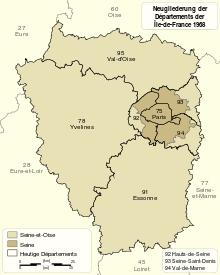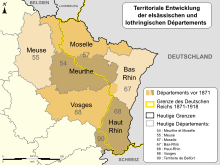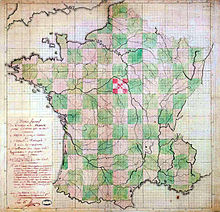Departments of France
![]()
This article is about territorial authorities in France or in French-governed territories. For other meanings, see department.
A département [depaʁtəˈmɑ̃] (French literally "department"; German spelling also Departement) is a territorial entity in France. The territory of the French Republic is divided into 101 departments according to central government structural principles. They are grouped into 18 regions (including Corsica with special status). 96 of the 101 départements are located in Europe, grouped into 13 regions. The remaining five départements are overseas départements (Guadeloupe, Martinique, French Guiana, Réunion, Mayotte) and each of the latter five also forms its own region. The island of Mayotte was the last department to be added in 2011.
Most departments have an area between 4000 and 8000 km² and a population between 250,000 and one million. The largest department in terms of area is French Guiana (83,534 km²), the largest in terms of area in Europe is Gironde (10,000 km²), the smallest is Paris (105 km²); the most populous is Nord (2,555,020 inhabitants), the least populous is Lozère (74,000 inhabitants).
All departments are numbered - in largely alphabetical order - with the number simultaneously forming the last two digits of the vehicle registration number (until 2009) and, as a rule, the first digits of the postcode. The municipality key also contains the department number, as does the social security number, which contains the key of the municipality of birth.
_-_colored_(Paris_zoom).svg.png)
Imágenes principales Map of the French Départements in Europe .
Internal organization
The chief administrative officer of a département is the government-appointed prefect (French préfet), who heads the prefecture (French préfecture).
The highest elected body of a département is the département council (French: conseil départemental). The decentralisation laws of 1982 strengthened the position of the council vis-à-vis the prefect.
For administrative purposes, the departments are divided into 335 arrondissements (as of 1 January 2015). The arrondissements serve to decentralise the departmental administration. In the main towns of arrondissements that are not also the main town of the department, a sub-prefecture (French sous-préfecture) has its seat, which is headed by a sub-prefect (French sous-préfet). Furthermore, the departments are divided into cantons. They serve primarily as electoral districts for the election of members of the département council (until 2013 cantonal elections, since then département elections). Arrondissements and cantons are not self-governing units like the regions, départements and municipalities.
The 35,945 municipalities (communes) are the lowest level of self-government (as of 1 January 2016).
The city of Paris, which is both a département and a municipality, has a special position. Here, the city council also exercises the function of the conseil départemental.
History
1789 until 1815
See also: French departments in Central Europe from 1792 to 1814
The départements, like the communes, were introduced in 1789/1790 during the French Revolution. On 3 November 1789, Jacques Guillaume Thouret, a deputy in the National Assembly, proposed the division of France into 80 départements ("subdivisions"), following a draft by Emmanuel Joseph Sieyès. These were to be, as far as possible, rectangles with sides of 18 miles (about 72 kilometers) and further subdivided into equally rectangular districts and cantons. Count Mirabeau, on the other hand, proposed a division into 120 départements, the boundaries of which were to be based on natural features. The law of 26 February 1790 essentially followed Mirabeau's designs by dividing France into 83 départements of roughly equal size. As a measure of the size of a département, it was stipulated that the border should not be more than a day's ride on horseback from the capital of the département. This new division of France into departments came into force on 4 March 1790.
In order to make the complete break with tradition clear, following a suggestion by Mirabeau, all departments were named uniformly according to geographical or historical (traditional) circumstances and not according to the historical provinces. This practice was only deviated from in 1860 after the annexation of Savoy with the new departments of Savoie and Haute-Savoie; this was probably done because Napoleon III wanted to exploit the territorial gain permanently for propaganda purposes. (In 1792, Savoy had still been given the name Mont-Blanc during the first annexation).
Each département was given an assembly (assemblée) of 36 elected members in 1790, who elected a president and a permanent executive directorate (directoire exécutif permanent). The départements were divided into up to nine districts each and the districts into up to nine cantons each.
In 1795, the internal organization of the departments was reorganized. The districts were abolished and the administration was concentrated at the level of the main towns of the cantons at the expense of the communes.
The law of 28 Pluviôse of year VIII (17 February 1800) again modified the internal structure of the départements. The departments were divided into arrondissements and cantons, fewer in number than the districts and cantons of 1790. The prefectures and sub-prefectures were created, as well as the general councils. The prefect (French préfet), appointed by the government, became the chief administrative officer of a department with very broad powers. This structure remained in place after the Bourbon Restoration of 1814/1815.
During Napoleonic rule, the number of départements increased considerably in line with the territorial expansion of France, reaching an all-time high of 130 in 1811/12.
1815 until 1919
At the time of the Restoration, the departmental division continued. France remained divided into 86 départements. The three additional départements were Vaucluse (from the former papal possession of Venaissin), Tarn-et-Garonne and Rhône or Loire (created by the division of the département of Rhône-et-Loire). With the acquisition of Savoy and the region around Nice after the Sardinian War, the three departments of Savoie, Haute-Savoie and Alpes-Maritimes were added in 1860. In 1871, after the Franco-Prussian War, the two Alsatian departments of Bas-Rhin and Haut-Rhin (for the most part) and parts of the departments of Meurthe, Moselle (for the most part) and Vosges were lost. The part of Haut-Rhin that remained with France was organized as the Territoire de Belfort, and the remaining parts of Meurthe and Moselle were merged to form the new department of Meurthe-et-Moselle. The law of August 10, 1871, introduced the election of the general councils by universal suffrage with the cantons as constituencies. Thereafter, the internal organisation of the départements remained unchanged for more than 100 years.
1919 until today
When the territories lost in 1871 rejoined France in 1919, the old pre-1871 département boundaries were not restored, but the reclaimed territories were reorganized in the form of three départements (Moselle, Bas-Rhin and Haut-Rhin). Since then, the departmental boundaries have remained largely unchanged. Only in 1968 was there a redivision of the departments of Île-de-France (see below) and in 1975 the department of Corse was divided into the two departments of Corse-du-Sud and Haute-Corse.
The 1982 decentralisation law extended the competences of the départements. Decentralisation transferred numerous competences to the elected bodies of the municipalities (conseil municipal - municipal council), départements (conseil général - general council) and regions (conseil régional - regional council), inter alia in the fields of town planning and regional planning, housing, transport and environmental policy and social and health care. The Prefect (temporarily called Commissaire de la République) had to hand over large parts of his powers to the President of the General Council, to whom the law of 2 March 1985 entrusted the management of the departmental executive.
Redivisions and renamings of departments
The majority of the départements created in 1790 still exist today in unchanged form - a remarkable territorial continuity compared to other countries. However, a number of départements have been split up, created or renamed over the past 200 years. Almost all départements with the name components -Inférieur ("low", but also "bad") and Bas- ("under; low") have been given new names since the middle of the 20th century.
- 1791: Renaming of the department of Mayenne-et-Loire to Maine-et-Loire.
- 1792: The department of Mont-Blanc (capital: Chambéry) is formed from Savoy, which was annexed by France.
- 1793: After the annexation of the Raurach Republic (part of the Jura with Pruntrut as its capital), the 84th and smallest département of Mont-Terrible is formed, incorporated into the département of Haut-Rhin in 1800.
- 1793: Renaming of the department of Gironde to Bec-d'Ambès (on the occasion of the arrest of the Girondists).
- 1793: Division of the department of Corse (Corsica) (capital: Bastia) into two departments, Golo (capital: Bastia) and Liamone (capital: Ajaccio).
- 1793: Division of the Rhône-et-Loire department into the Rhône and Loire departments.
- 1793: After the annexation of the county of Venaissin (former papal enclave), the principality of Orange and Avignon, the department of Vaucluse is created.
- 1793: After the annexation of Nice, the Département Alpes-Maritimes (capital: Nice) is created.
- 1795: The department Bec-d'Ambès gets the name Gironde again.
- 1795: The department of Paris is renamed the Seine.
- 1798: After the annexation of Geneva, the Département Léman (capital: Geneva) is formed from the city, the northern part of the Département Mont-Blanc and part of the Département Ain.
- 1808: The department of Tarn-et-Garonne is formed from parts of the departments of Aveyron, Haute-Garonne, Gers, Lot and Lot-et-Garonne.
- 1811: The departments of Golo and Liamone are reunited to form the department of Corse (Corsica) (capital now: Ajaccio).
- 1814: Since Geneva rejoins Switzerland, the Department of Léman is dissolved and the Department of Ain is restored, with the exception of a few communes (land link between Geneva and Vaud), to the parts lost in 1798 and also some territories to the part of the Department of Mont-Blanc that remained with France in 1814.
- 1815: With Savoy and Nice rejoining the Kingdom of Sardinia, the departments of Mont-Blanc and Alpes-Maritimes are dissolved.
- 1860: Following the cession of Savoy and the county of Nice by the Kingdom of Sardinia, the departments of Savoie, Haute-Savoie and Alpes-Maritimes were created; the department of Alpes-Maritimes included the former county of Nice and the arrondissement of Grasse, which until then had belonged to the department of Var.
- 1871: The entire Département of Bas-Rhin, most of the Départements of Haut-Rhin and Moselle, and parts of the Départements of Meurthe and Vosges are ceded to the German Empire as Alsace-Lorraine. The parts of the departments of Meurthe and Moselle that remained with France were united to form the department of Meurthe-et-Moselle. The part of the department of Haut-Rhin remaining with France forms the Territoire de Belfort, which has the status of a remaining arrondissement of Haut-Rhin with an administrateur instead of the prefect and a commission départementale instead of the general council.
- 1919: With the reintegration of Alsace-Lorraine, the departments of Bas-Rhin, Haut-Rhin (without the Territoire de Belfort) and Moselle (including the part of the former department of Meurthe that had in the meantime become part of the German Reich) were newly formed.
- 1922: The Territoire de Belfort becomes a regular département.
- 1941: Renaming of the department of Charente-Inférieure to Charente-Maritime.
- 1946: The overseas territories of Guadeloupe, French Guiana (Guyane française), Martinique and Réunion become overseas departments (départements d'outre-mer).
- 1955: Renaming of the department Seine-Inférieure to Seine-Maritime.
- 1957: Renaming of the Loire-Inférieure department to Loire-Atlantique.
- 1968 (under a 1964 law): the departments of the Île-de-France region are reorganised: the department of Seine is divided into four new departments: Paris (comprising only the city of Paris), Hauts-de-Seine, Seine-Saint-Denis and Val-de-Marne. The latter three departments also include some communes that were previously part of the department of Seine-et-Oise. This will be divided into three new départements: Yvelines, Essonne and Val-d'Oise.
- 1969: The Basses-Pyrénées department is renamed Pyrénées-Atlantiques.
- 1970: The Basses-Alpes department is renamed Alpes-de-Haute-Provence.
- 1975: The department of Corse (Corsica) is divided into the departments of Corse-du-Sud and Haute-Corse.
- 1990: Renaming of the department Côtes-du-Nord to Côtes-d'Armor.
- 2011: The overseas territory of Mayotte becomes an overseas department (département d'outre-mer).
- 2015: The Lyon metropolitan area is hived off from the Rhône department and reorganised as a special-status territorial entity performing the functions of a department and an association of municipalities. It retains the order number 69 and shares it with the department of Rhône proper.
- 2018: Corsica acquires the status of a Collectivité territoriale, the départements are dissolved and their administration merged with that of the region.

1968:Reorganization of the departments of Île-de-France

1871 and 1919-1922: change of departmental boundaries on the loss and recovery of Alsace-Lorraine

Proposal of a departmental division based on natural conditions
-de.svg.png)
Departmental division of France in 1812

Proposal by Sieyès and Thouret of a "geometric" division into square departments, cantons and communes.
Questions and Answers
Q: What are départements?
A: Départements are administrative parts of France and many French colonies, similar to English counties.
Q: What is the purpose of départements?
A: Départements serve as a kind of local government.
Q: How many départements are there in France?
A: There are 101 départements in France.
Q: Are the départments grouped into regions?
A: Yes, the 101 French départments are now grouped into 13 metropolitan and five overseas régions.
Q: What is the capital of each department called?
A: The capital of each department is called a préfecture.
Q: Are there any other countries that have similar systems to French departments?
A: Yes, many French colonies also have similar systems to French departments.
Search within the encyclopedia